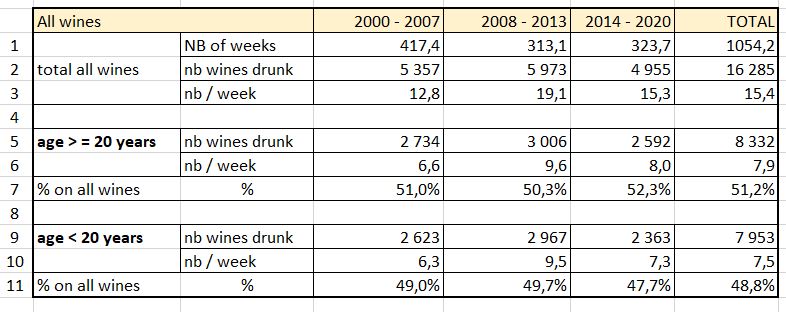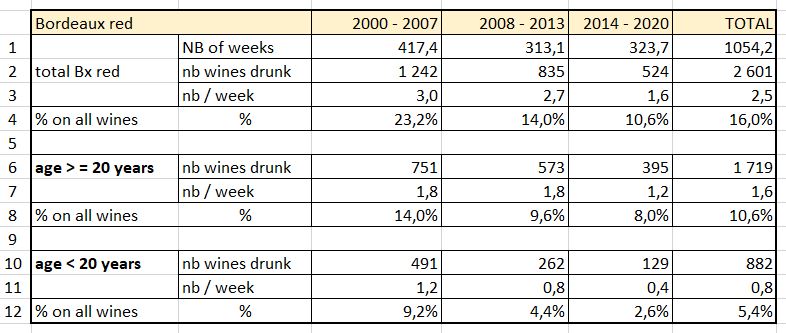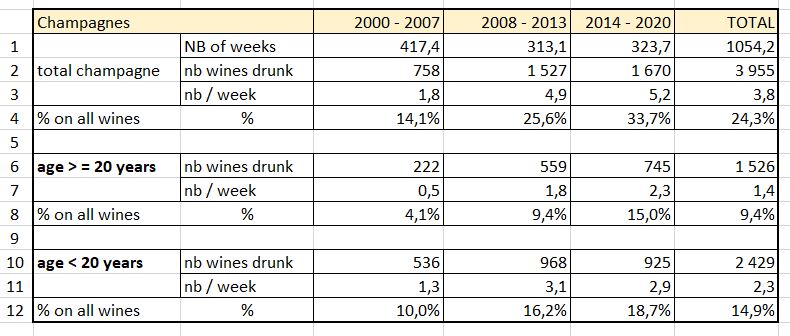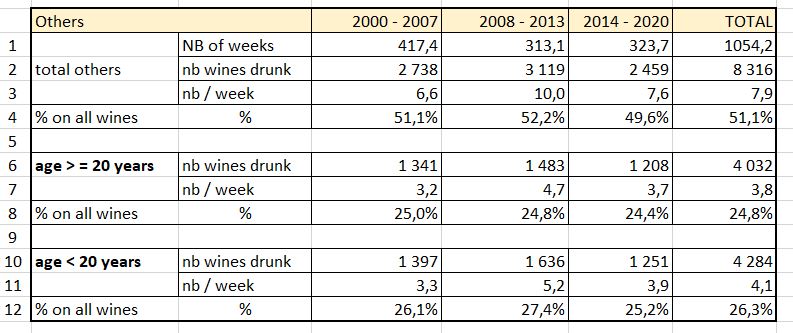I have made a study of what I drink for the last 20 years, because I have a data base on that, for 16285 wines drunk. I chose a criteria of age which is : drunk when the wine has less than 20 years, or when the wine has 20 years or more. It is not a study on millesimes, but a study on age of consumption. To understand well what it means, let us take the year 1990. The wines of 1990 that I drank on the period 2000 – 2009 are in the category ‘less than 20 years’ and the wines of 1990 that I drank on the period 2010 – 2020 are in the category ’20 years or more’.
I studied that per region or per color of wine.
Having made this study I found that over the time, there is a collapse of Bordeaux and an explosion of champagnes in my consumption.

Let’s first look at general consumption in three periods: 2000 to 2007, 2008 to 2013 and 2014 to 2020 (as of March 15). These are periods of 417 weeks, 313 weeks and 324 weeks, of which the numbers of wine drunk are fairly close: 5357 - 5973 – 4955 (line 2).
In the first period I was still active in my industrial companies, which explains a lower consumption, or at least, I drank in my industrial activity wines for which I did not always take notes. The second period is one of full activity in my hobby. The pace drops a bit in the third period, and it’s not impossible that age plays a role.
The distribution of consumption between wines of ‘20 years and more’ and wines of ‘less than 20 years’ is fairly stable, the percentage of 20 years and more evolving thus: 51% - 50.3% and 52.3%.
Note that I drink two wines per day over twenty years, which is important. But the wines of my dinners are shared between ten or eleven people and those on other occasions are drunk between three and ten people, and the wines drunk at the winemaker’s place or in the salons are served in portions for about twenty people, this which makes my consumption relatively low, to which is added the use of a timpani to spit out what I drink, except the champagnes.
Second note, it is generally said that I drink only old wines, but young wines represent 48,8% of what I drink, because there are many occasions in which young wines are served like winemaker’s place or restaurants, or dinner in friends’ homes.

Now let’s look at the situation of the red Bordeaux, which shows a particular collapse. Consumption of red Bordeaux fell from 3 per week to 1.6, which is almost halved. And compared to general consumption, the red Bordeaux decreased from 23.2% to 10.6%. It has dropped by more than half. For Bordeaux under 20 years, it is a great collapse, with a division by three, of 1.2 wine per week to 0.4. This is certainly voluntary, since I find that the red Bordeaux of less than 20 years are far from having reached what they are able to express. But it is also linked to the fact that after buying the 2000 vintage, I stopped buying Bordeaux for two reasons: on the one hand, their price, since for many wines the price of old wines is lower than the price of recent wines from great years and secondly because it is unlikely that I will drink the young Bordeaux in my lifetime. I have only kept purchases of recent wines when I benefit from allocations which require me to buy all vintages. I am surprised that the old Bordeaux wines, which I adore, fell by one third in my consumption over the period 2014-2020 because I have stocks in my cellar that would have allowed me to drink them, even without purchasing. The reason is probably the rise of champagnes.

My consumption of champagnes has almost tripled, with consumption per week of 1.8 - 4.9 and 5.2 bottles per week. The consumption of old champagnes has almost increased fivefold. I drink almost twice as much old champagnes as old red bordeaux, whereas I drank three times less in the first period.

If we look at what is neither champagne nor red bordeaux we see a set of great stability, which seems to show that there has been a phenomenon of communicating vases between red bordeaux and champagnes, for reasons that are not of substitution, because the construction of wine’s types accompanying the meals is little changed but it is due to a love for champagnes and especially old champagnes and a disenchantment for the young red bordeaux which reflected on the old ones too.
What can be taken from this study? I am not really a normal consumer, so my experience cannot be taken as general. But contrarily to people who write on wines, I never drink a wine because I have an obligation to drink it because I will publish a study. I drink a wine because I want to drink it and I am fully free.
I have discovered old champagnes lately, in the 90ies, and my love of old champagnes has dramatically expanded. But why has it only affected my love for red Bordeaux. I think that I have been influenced by the evolution of the prices at the beginning of the 21st century. Crazy prices (for my opinion) when buying and crazy prices in restaurants.

I could have thought that the decrease of Bordeaux would have helped a development of Rhône. It is not the case. And despite a very strong explosion of Burgundy prices, Burgundy has not decreased.
The more probable explanation of the collapse of red Bordeaux is that I am a disappointed lover of red Bordeaux.